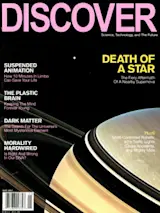On a gray midwinter dawn, a dozen scientists and technicians in hard hats gather outside the entrance to the Soudan Mine. Wearing heavy coats and clutching lunch bags, they step expectantly into the open cage of an 80-year-old hoist. An ancient engine chuffs as it lowers a steel gondola down the mine’s 2,341-foot-long shaft. The trip takes three minutes, but the passengers do not talk much. Instead, they listen idly to the icy air swooshing upward as the cage plunges into the guts of northeastern Minnesota’s Iron Range, away from the snowdrift-filled landscape and into a world of darkness.
The scene echoes an ordinary day at the mine more than a century ago. The Soudan Mine opened in 1884 atop one of the richest iron deposits in the world—hard hematite, about 65 percent pure. The ore quality kept Soudan going until 1962, when U.S. Steel decided that the mine had ...














